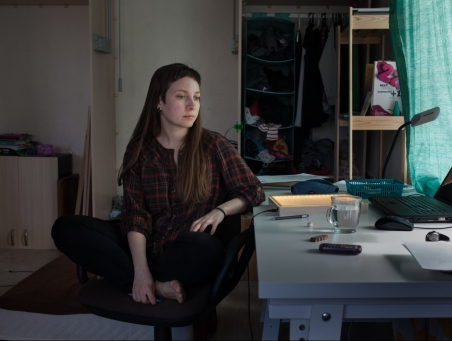Cost-effective Reporting

In February 2014, I became the first journalist from Kyrgyzstan to travel to Ukraine to cover Euromaidan, a series of opposition protests that resulted in deadly clashes between security forces and pro-European protesters, which eventually led to the ouster of Russian-backed president, Viktor Yanukovych.
Three months later, I was back in Ukraine – the first journalist from my country to report from the East on the developing military conflict between Ukrainian forces and Russian-backed separatists.
Why did I go? I felt I had no choice. So many people in Kyrgyzstan had such a distorted understanding of what was going on in Ukraine due to the one-sided coverage provided by the most popular media outlets.
This post is a result of the 2015 n-ost Media Conference, "Translating Worlds," which took place in November 2015. For more essays on foreign reporting and theses on photojournalism, please see the brochure below, or visit our website on the conference.
My country was – and still is – very much under the influence of Russian state TV channels. They are accessible to almost everybody who owns a television; they regularly breached journalistic standards while covering Euromaidan and the ensuing military conflict.
News outlets from other countries are not popular in Kyrgyzstan. This is mostly because of the language barrier—English-speaking people are a tiny minority. So regardless of the good work foreign outlets produce, they don’t reach most people in my country.
There is high-quality, Russian-language journalism, too, but mostly by independent newspapers rather than broadcasters; their websites are not popular in Kyrgyzstan.
Kyrgyz media was either silent or would re-broadcast stories from Russia.
I knew I had to do something about the situation. I felt there was no other way than to go there, see with my own eyes and publish on my own website, Kloop, which by then was already one of the five most-popular news websites in the country.
I wanted to provide my readers with stories that would adhere to fair reporting standards and offer an alternative to TV. Although Kloop was not as popular as Russian television, I hope that I helped the tens of thousands of people who read my Ukrainian stories to better understand what was happening there.
If the tools exist, why not exploit them?
Kyrgyzstan is clearly not the only country with journalists who rarely—or never—travel abroad. This fact has become the norm in most countries.
There is a very visible top-down approach to foreign reporting, and, obviously, the main reason is economic. Often, only media outlets from rich countries can afford to send journalists abroad. That leaves most of the global population relying on a relatively small number of outlets for their access to the world's most important stories.
The English-speaking world is luckier – there is competition between America's biggest media outlets and some British ones. There are also alternative online outlets emerging—a positive development, although most remain concentrated in the United States.
The Spanish-speaking world has much less choice, while Russian- and Chinese-speaking media are dominated by state-owned giants.
There are so many new voices on the Internet and on social media that generate opportunities for diversity in reporting—we have built so many tools to connect diverse parts of the world.
But the fact remains that these tools go unexploited, especially for international news coverage.
High-quality, low-budget
The first priority is developing, promoting and teaching cost-effective foreign reporting in poorer countries. Before traveling to Ukraine, I often heard complaints that foreign reporting is just too expensive for Kyrgyz media outlets.
There's no denying that costs are a barrier, but I managed to overcome them.
Kloop is run by a non-profit; it’s safe to say that it’s definitely not the richest outlet in Kyrgyzstan. At the time of the Euromaidan protests, we certainly did not have "unexpected trips abroad to cover revolution and conflict" earmarked in our budget.
But I worked out how to travel cheaply. My first trip to Kyiv, which lasted slightly less than a week, cost me about 500 Euros, which I paid for out-of-pocket. This included round-trip airfare, accommodations, meals and transportation within the Ukrainian capital.
Most media outlets—even in poorer countries like Kyrgyzstan—can afford a 500 Euro expenditure. Journalists can couch surf (which I did later in eastern Ukraine), for instance, and they can travel inexpensively by bus within Europe.
It’s true that cutting costs might affect their work; for example, they might be slower than colleagues from rich outlets. But they are working for a different target audience and at least this way they’re able to get something published.
Making technology work for journalists
The second solution is to exploit already existing tools in order to cooperate with colleagues abroad. I’m actually working on this at the moment — my next start-up involves connecting journalists from all over the world to make it much easier to collaborate on stories.
Technology makes this possible. Even in many poorer countries, 3G networks are widespread, enabling journalists thousands of miles apart to work together in real-time. And innovative online money transfer systems can facilitate international payments for journalists.
Technology has been quickening the pace of global decentralization for a while now. It's about time the same processes were applied to the world of journalism.
The 2015 n-ost Media Conference, "Translating Worlds," yielded five essays on the challenges facing today's foreign correspondent, as well as a series of seven photo-theses concerning modern photojournalistic practice. The complete works can be found in this brochure.

